
Giovanni Bellini was an Italian Renaissance painter, probably the best known of the Bellini family of Venetian painters. He was raised in the household of Jacopo Bellini, formerly thought to have been his father, but now that familial generational relationship is questioned. An older brother, Gentile Bellini was more highly regarded than Giovanni during his lifetime, but the reverse is true today. His brother-in-law was Andrea Mantegna.
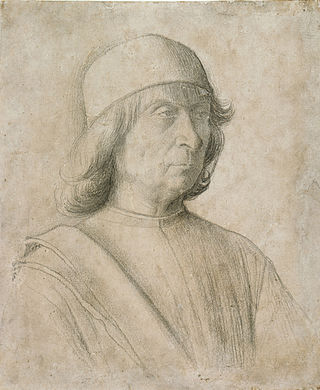
Gentile Bellini was an Italian painter of the school of Venice. He came from Venice's leading family of painters, and at least in the early part of his career was more highly regarded than his younger brother Giovanni Bellini, the reverse of the case today. From 1474 he was the official portrait artist for the Doges of Venice, and as well as his portraits he painted a number of very large subjects with multitudes of figures, especially for the Scuole Grandi of Venice, wealthy confraternities that were very important in Venetian patrician social life.

Jacopo Bellini was one of the founders of the Renaissance style of painting in Venice and northern Italy. His sons Gentile and Giovanni Bellini, and his son-in-law Andrea Mantegna, were also famous painters.

Giovanni Santi was an Italian painter and decorator, father of Raphael. He was born in 1435 at Colbordolo in the Duchy of Urbino. He studied under Piero della Francesca and was influenced by Fiorenzo di Lorenzo. He was court painter to the Duke of Urbino and painted several altarpieces. He died in Urbino.

St. Francis in Ecstasy is a painting by Italian Renaissance master Giovanni Bellini, started in 1475 and completed around 1480. Bellini depicted the religious figure of St. Francis of Assisi in a landscape. In 1852, the painting was listed on June 19 at Christie's. It was part of the 1857 Manchester Art Treasures exhibition. In 1915, Henry Clay Frick bought the painting for $170,000, and it remains in the Frick Collection, in New York City.
The decade of the 1490s in art involved some significant events.
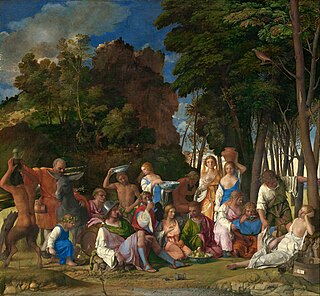
The Feast of the Gods is an oil painting by the Italian Renaissance master Giovanni Bellini, with substantial additions in stages to the left and center landscape by Dosso Dossi and Titian. It is one of the few mythological pictures by the Venetian artist. Completed in 1514, it was his last major work. It is now in the National Gallery of Art in Washington D.C., which calls it "one of the greatest Renaissance paintings in the United States".

Crucifixion is a painting by the Italian Renaissance painter Giovanni Bellini, created around 1455–1460. It is housed in the Museo Correr in Venice.

Venetian painting was a major force in Italian Renaissance painting and beyond. Beginning with the work of Giovanni Bellini and his brother Gentile Bellini and their workshops, the major artists of the Venetian school included Giorgione, Titian, Tintoretto (1518–1594), Paolo Veronese (1528–1588) and Jacopo Bassano (1510–1592) and his sons. Considered to give primacy to colour over line, the tradition of the Venetian school contrasted with the Mannerism prevalent in the rest of Italy. The Venetian style exerted great influence upon the subsequent development of Western painting.

The Presentation at the Temple is a painting of the Presentation of Jesus at the Temple by the Italian master Giovanni Bellini, dating to c. 1460. It is housed in the Fondazione Querini Stampalia, in Venice, Italy.
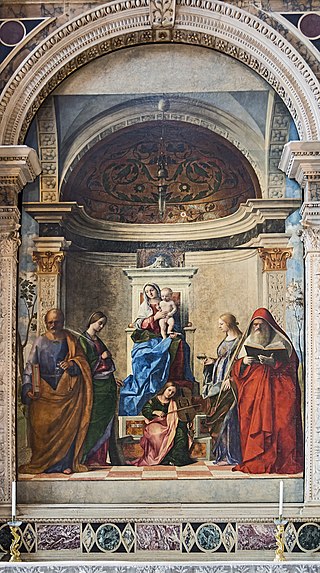
The San Zaccaria Altarpiece is a painting by the Italian Renaissance painter Giovanni Bellini, executed in 1505 and located in the church of San Zaccaria, Venice.

The Presentation at the Temple is a painting by the Italian Renaissance artist Andrea Mantegna. Dating to c. 1455, it is housed in the Gemäldegalerie, Berlin, Germany.
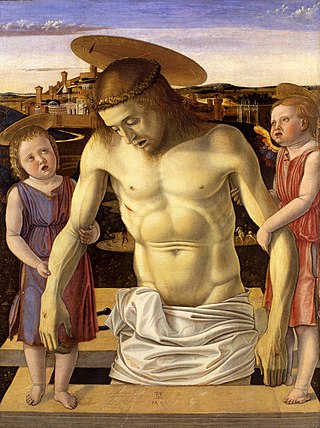
Dead Christ Supported by Two Angels is a tempera painting on panel by Italian Renaissance painter Giovanni Bellini, created around 1460. It is housed in the Museo Correr in Venice.

St. Mark Preaching in Alexandria is an oil painting by the Italian Renaissance artists Gentile and Giovanni Bellini, dated to 1504–1507, and held in the Pinacoteca di Brera, in Milan.

Dead Christ Supported by Two Angels is a tempera-on-panel painting by the Italian Renaissance painter Giovanni Bellini, now in the Gemäldegalerie, Berlin. It is dated to 1465–1470, as shown by similarities to his 1464 San Vincenzo Ferrer Polyptych, an early mature work.

The Madonna and Child is a tempera-on-panel painting usually attributed to the Italian Renaissance artist Giovanni Bellini, dated to 1450–1460 or to 1450–1455 by Pignatti, though Olivari and others consider this to be too early. In the 1450s the painter was still heavily influenced by his father Jacopo and by Bartolomeo Vivarini. The strong line used for the Christ Child also shows the influence of Francesco Squarcione and his studio on the young Bellini. The general composition is based on a widely copied Byzantine icon in Venice, whilst the Christ Child holds a Flemish-style scroll bearing the artist's signature. The painting is closely linked to a similar work now in Philadelphia. It is now in the Pinacoteca Malaspina in Pavia.

The Lehman Madonna is a c.1470 tempera-on-panel painting of the Madonna and Child by the Venetian painter Giovanni Bellini.

The Frizzoni Madonna is a 1460–1464 painting by the Italian Renaissance painter Giovanni Bellini. It was once part of the Frizzoni collection in Bergamo. It entered the Museo Correr in Venice in 1891, the same year as it was identified as a work by Bellini. It was originally an oil-on-wood painting, but it was transferred to canvas before entering the Museo Correr.

Madonna and Child with Saint Mary Magdalene and Saint Ursula or Virgin and Child with Saints Magdalene and Ursula is an oil on panel painting by Giovanni Bellini that belongs to the sacra conversazione genre and dates to 1490. The painting is also referred to as Sacred Conversation. It was previously in the collection of the painter Carlo Maratta, and is now in the Prado Museum in Madrid.
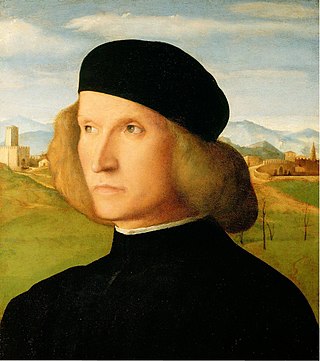
Portrait of a Young Man is a c.1505 oil-on-panel painting by the Italian painter Giovanni Bellini. It is the latest surviving portrait by the artist, drawing on the work of Antonello da Messina and Dutch painters of the time. It is also the only portrait in which he included a landscape behind the sitter. He signed it on a cartouche on the trompe-l'œil marble parapet in the foreground.



















